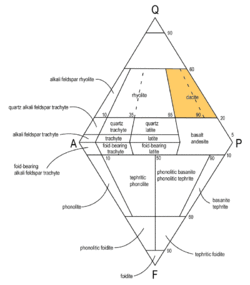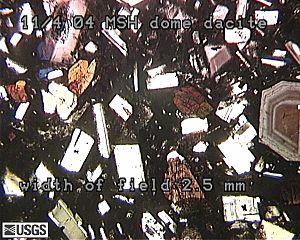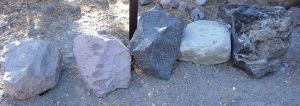- Dacite
-
 Aphanitic QAPF diagram denoting dacite
Aphanitic QAPF diagram denoting dacite
Dacite (
 /ˈdeɪsaɪt/) is an igneous, volcanic rock. It has an aphanitic to porphyritic texture and is intermediate in composition between andesite and rhyolite. The relative proportions of feldspars and quartz in dacite, and in many other volcanic rocks, are illustrated in the QAPF diagram. Dacite is also defined by silica and alkali contents in the TAS classification.
/ˈdeɪsaɪt/) is an igneous, volcanic rock. It has an aphanitic to porphyritic texture and is intermediate in composition between andesite and rhyolite. The relative proportions of feldspars and quartz in dacite, and in many other volcanic rocks, are illustrated in the QAPF diagram. Dacite is also defined by silica and alkali contents in the TAS classification.The word dacite comes from Dacia, a province of the Roman Empire which lay between the Danube River and Carpathian Mountains (now modern Romania) where the rock was first described.
Contents
Composition
Dacite consists mostly of plagioclase feldspar with biotite, hornblende, and pyroxene (augite and/or enstatite). It has quartz as rounded, corroded phenocrysts, or as an element of the ground-mass.
The plagioclase ranges from oligoclase to andesine and labradorite. Sanidine occurs, although in small proportions, in some dacites, and when abundant gives rise to rocks that form transitions to the rhyolites.
The groundmass of these rocks is composed of plagioclase and quartz.
Texture
In hand specimen many of the hornblende and biotite dacites are grey or pale brown and yellow rocks with white feldspars, and black crystals of biotite and hornblende. Other dacites, especially pyroxene bearing dacites, are darker colored.
In thin section, dacites may have an aphanitic to porphyritic texture. Porphyritic dacites contain blocky highly zoned plagioclase phenocrysts and/or rounded corroded quartz phenocrysts. Subhedral hornblende and elongated biotite grains are present. Sanidine phenocrysts and augite (or enstatite) are found in some samples. The groundmass of these rocks is often aphanitic microcrystalline, with a web of minute feldspars mixed with interstitial grains of quartz or tridymite; but in many dacites it is largely vitreous, while in others it is felsitic or cryptocrystalline.
Geological context and formation
 Thin section of a porphyritic dacite from Mount St. Helens
Thin section of a porphyritic dacite from Mount St. Helens
Dacite usually forms as an intrusive rock such as a dike or sill. Examples of this type of dacite outcrop are found in northwestern Montana and northeastern Bulgaria. Nevertheless, because of the moderate silica content, dacitic magma is quite viscous[1] and therefore prone to explosive eruption. A notorious example of this is Mount St. Helens in which dacite domes formed from previous eruptions.
Dacitic magma is formed by the subduction of young oceanic crust under a thick felsic continental plate. Oceanic crust is hydrothermally altered causing addition of quartz and sodium.[2] As the young, hot oceanic plate is subducted under continental crust, the subducted slab partially melts and interacts with the upper mantle through convection and dehydration reactions.[3] The process of subduction creates metamorphism in the subducting slab. When this slab reaches the mantle and initiates the dehydration reactions, minerals such as talc, serpentine, mica and amphiboles break down generating a more sodic melt.[4] The magma then continues to migrate upwards causing differentiation and becomes even more sodic and silicic as it rises. Once at the cold surface, the sodium rich magma crystallizes plagioclase, quartz and hornblende.[5] Accessory elements like pyroxenes provide insight to the history of the magma.
The formation of dacite provides a great deal of information about the connection between oceanic crust and continental crust. It provides a model for the generation of felsic, buoyant, perennial rock from a mafic, dense, short-lived one.
Dacite's role in the creation of Archean continental crust
The process by which dacite forms has been used to explain the generation of continental crust during the Archean eon. At that time, the fabrication of dacitic magma was more ubiquitous due to the availability of young hot oceanic crust. Today, the colder oceanic crust that subducts under most plates is not capable of melting before the dehydration reactions therefore inhibiting the process.[6]
Molten dacite magma at Kīlauea
Dacite magma was encountered in a drillhole during geothermal exploration on Kīlauea in 2005. The magma was encountered at a depth of 2488 m and was repeatedly drilled as it surged up the drillhole and quenched over a range of 8 m. The dacite magma is a residual melt of the typical basalt magma of Kīlauea.[7]
References
- ^ Whittington, A., Hellwig, B., Behrens, H., Joachim, B., Stechern, A., Vetere, F., (2009) The viscosity of hydrous dacitic liquids: Implications for the rheology of evolving silicic magmas. Bulletin of Volcanology 71, 185-199.
- ^ DeVore, G. (1983) The influence of submarine weathering of basalts on their partial melting during subduction. Lithos 16, 203-213.
- ^ Drummond, M. S. and Defant, M. J., 1990, A model for trondhjemite-tonalite-dacite genesis and crustal growth via slab melting. Journal Geophysical Research 95, 21,503-21,521.
- ^ Fyfe, W., McBirney, A. (1975) Subduction and the structure of andesitic volcanic belts. American Journal of Science 275-A, 285-297.
- ^ Defant, M., Richerson, P., De Boer, J., Stewart R., Maury, R., Bellon, H., Drummond, M., Feigenson, M (1991) Dacite Genesis via both Slab Melting and Differentiation: Petrogenesis of La Yeguada Volcanic Complex, Panama. Journal of Petrology 32, 1101-1142
- ^ Atherton, M., Petford, N (1993) Generation of sodium-rich magmas from newly underplated basaltic crust. Nature 362, 144-146.
- ^ http://www.agu.org/meetings/fm08/fm08-sessions/fm08_V23A.html Puna Dacite Magma at Kilauea: Unexpected Drilling Into an Active Magma Posters, 2008 Eos Trans. AGU, 89(53), Fall Meet.
Igneous rocks by composition Type Ultramafic
< 45% SiO2Mafic
45-52% SiO2Intermediate
52–63% SiO2Intermediate-Felsic
63–69% SiO2Felsic
>69 % SiO2Volcanic rocks:
Subvolcanic rocks:
Plutonic rocks:Dacite
GranodioriteCategories:- Intermediate rocks
- Felsic rocks
- Aphanitic rocks
- Porphyritic rocks
- Volcanic rocks
Wikimedia Foundation. 2010.


